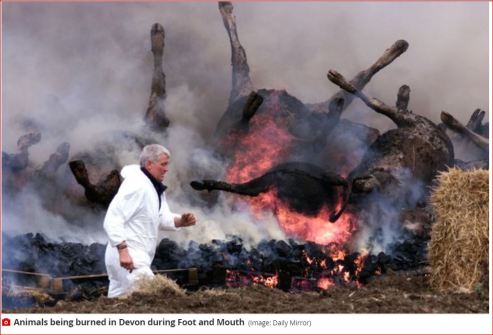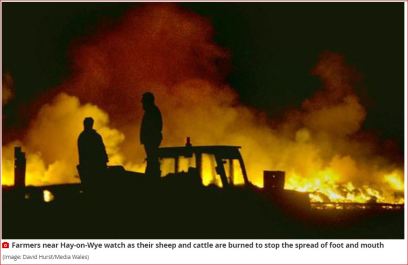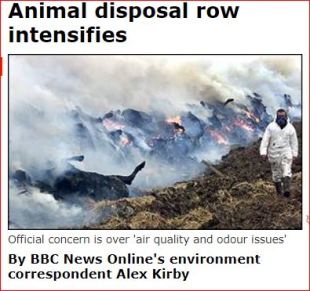

Images above, April 12, 2020, “The full horrifying scale of the 2001 foot and mouth outbreak told by the Welsh farmers in the middle of it,“ walesonline.co.uk, Anna Lewis

Image above, April 13, 2001, “Scientists back rapid slaughter policy,” BBC, “No alternative this time around, say scientists.”

Image above, May 30, 2001, “100 days of Foot and Mouth,” BBC

Image above, 4/4/2001, “Animal disposal row intensifies,” BBC
……………………………………
2011 Abstract: *Animals aren’t infectious until half a day after clinical signs appear:
*“The infectious period is shorter (mean 1.7 days) than currently realized, and animals are not infectious until, on average, 0.5 days after clinical signs appear.”
*2011 study says vaccinations are fine. “Then, there was concern that vaccination would lead to animals becoming infected at a very low level without displaying symptoms, and that these animals could in turn have infected animals in other farms….This kind of subclinical infection is not a worry….
Vaccinating in the face of an outbreak might be more effective than scientists previously thought.…If an animal does not show symptoms, it is not infectious.”
*Importantly, the researchers also discovered that animals were not infectious until they showed symptoms of the disease.
*Scientists had previously thought animals were infectious for hours or even days before manifesting any symptoms.
*By exposing calves to infected cattle and closely monitoring them, researchers from the Institute for Animal Health in Surrey and Edinburgh University discovered that the period of infection was less than two days.”
Slaughters took place on 131,000 UK farms …April 13, 2001, “Scientists back rapid slaughter policy,” BBC
……………………
May 6, 2011, “Mass culling for foot-and-mouth ‘may be unnecessary‘,” BBC News,
“The mass cull of farm animals to control the spread of foot-and-mouth disease may be unnecessary if there is a new outbreak, scientists suggest.
A new analysis of disease transmission suggests that future outbreaks might be controlled by early detection and killing only affected animals….
“The mass cull of farm animals to control the spread of foot-and-mouth disease may be unnecessary if there is a new outbreak, scientists suggest.
A new analysis of disease transmission suggests that future outbreaks might be controlled by early detection and killing only affected animals….
The research, by a UK team, is reported in the journal Science.”…
[2011 “Abstract: Control of many infectious diseases relies on the detection of clinical cases and the isolation, removal, or treatment of cases and their contacts. The success of such “reactive” strategies is influenced by the fraction of transmission occurring before signs appear. We performed experimental studies of foot-and-mouth disease transmission in cattle and estimated this fraction at less than half the value expected from detecting virus in body fluids, the standard proxy measure of infectiousness. This is because the infectious period is shorter (mean 1.7 days) than currently realized, and animals are not infectious until, on average, 0.5 days after clinical signs appear. These results imply that controversial preemptive [slaughter] control measures may be unnecessary; instead, efforts should be directed at early detection of infection and rapid intervention.” May 6, 2011, “Relationship Between Clinical Signs and Transmission of an Infectious Disease and the Implications for Control," Science]
(continuing, BBC): “Until now, vets had assumed animals could be infectious while they carried the virus that causes foot-and-mouth, which may be for between four and eight days.
However, by exposing calves to infected cattle and closely monitoring them, researchers from the Institute for Animal Health in Surrey and Edinburgh University discovered that the period of infection was less than two days.
Perhaps more importantly, the researchers also discovered that animals were not infectious until they showed symptoms of the disease.
Scientists had previously thought animals were infectious for hours or even days before manifesting any symptoms.
These results suggest that any future outbreak could be brought under control by closely monitoring animals and slaughtering them as soon as they become ill.
This approach is in contrast to the policy adopted to bring the 2001 epidemic under control.
Too drastic
Ten years ago, the UK Government slaughtered not only all the animals on infected farms but also all animals on adjacent farms, regardless of whether infection had been reported there.
Foot and mouth: The facts
The policy of “contiguous culling” was adopted following scientific advice that this was the only way of controlling the epidemic.
It led to the slaughter of 6.5 million cattle, sheep and pigs, some of which were burned on open air pyres.
Many vets and farmers felt at the time – and still argue – that the policy was far too drastic, and that a more targeted approach would have been sufficient to bring the outbreak under control.
Dr Bryan Charleston, of the Institute for Animal Health, was among those asked to undertake the new study in response to public concern about the use of contiguous culling….
Writing in Science, his team says: “These results imply that controversial pre-emptive control measures may be unnecessary.
“Instead, efforts should be directed at early identification of infection and rapid intervention.”
Dr Charleston also told BBC News it would be worth developing simple test kits to detect herds that are infected before the onset of clinical signs, and also to detect herds that are not infected “so they would not need to be culled”.
Targeted approach
So if mass culling could be avoided in the future, why was it not “wrong” in 2001, as Dr Charleston argues?
Professor Neil Ferguson, of Imperial College London, was among those advising government on how to control the epidemic a decade ago.
He said the more targeted approach suggested by the new research would have been impossible by the time government had realised that there was a major outbreak.
“The biggest problem in 2001 was that by the time we realised what was happening, there were something between 30 and 50 infected farms [out of total of 131,000 farms],” he said.
“It took a huge amount of effort to deal with that, and so very intensive surveillance of infected areas proved impossible from the outset.”
But government agencies are now much better placed to detect new infections much earlier.
That being the case, the implications of this paper are that in future, vets will be able to nip foot-and-mouth outbreaks in the bud.
Indeed, this is what happened in 2007 when there was a small outbreak as a result of a leak of foot-and-mouth virus from [Pirbright high security] a laboratory in Surrey.
That outbreak was confined to a small area, and so vets were able to monitor closely and test herds that were in close proximity to infected animals.
Those that were found to have the virus were culled; those that tested negative were not.
This approach was sufficient to bring the 2007 outbreak under control. But such a scheme could not be applied to a larger outbreak, according to Professor Ferguson.
He said: “When the outbreak is very small, it becomes more feasible to pick up any signs of infection on a farm as soon as possible; and this research suggests that might be very effective at stopping onward transmission.
“But in 2001, really rapid diagnosis proved to be challenging.
“If you have a lot of animals on a lot of farms, it’s hard to inspect them all every day. So although the general conclusion is that rapid diagnosis might have a big effect, in practice, it might be hard to achieve (once the outbreak exceeds a certain size).”
The research also suggests that vets should not be wary of using vaccination to control any future outbreak, as they were in 2001.
Then, there was concern that vaccination would lead to animals becoming infected at a very low level without displaying symptoms, and that these animals could in turn have infected animals in other farms..
The new research, however, suggests that this kind of subclinical infection is not a worry.
It indicates that if an animal does not show symptoms, it is not infectious; so vaccinating in the face of an outbreak might be more effective than scientists previously thought.”
No comments:
Post a Comment